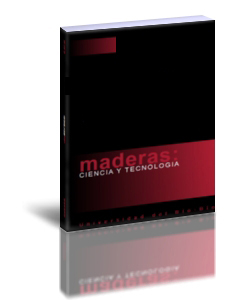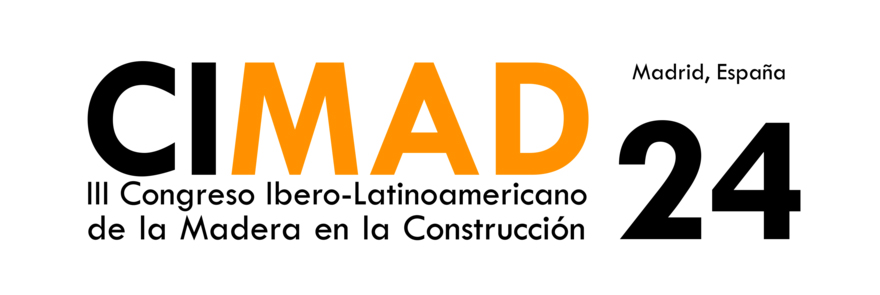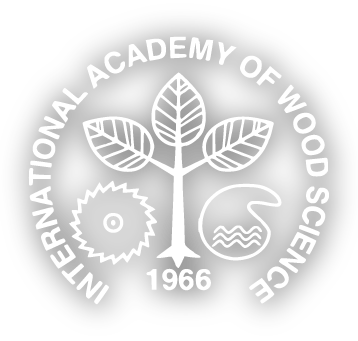Spruce chips stabilization in wood-cement materials: Effect of matrix composition
DOI:
https://doi.org/10.22320/s0718221x/2024.27Keywords:
Density, silicate matrix, spruce chips, swelling, wood-cement compositeAbstract
The problem of the presented research is stabilization of spruce chips in modified cement matrix of wood-cement composites and analysing the effect of the stabilisation on selected parameters of these composite materials. The matrix has an impact on the stabilization of the spruce wood content. Silicate ma- trix based on Portland and blended cement was modified by finely ground thermal power plant slag (TPPS) and limestone (LS). Four types of wood-cement composite were subjected to water immersion tests for 28 days. During water immersion, both swelling in thickness and mass changes were analysed. The amount of sugars and pH in leachate were determined after 7 day intervals. Mechanical properties and microstructures were analysed before and after water immersion. Different behaviour with regard to spruce chips stabilization was proved in dependence of wood-cement matrix modification. Differences in thickness, swelling and sugar leach indirectly indicate the influence of the wood-cement composites matrix composition on the stabiliza- tion of spruce chips contained in this matrix. Boards with the matrix modified with thermal power plant slag showed the highest thickness swelling (%) and sugar leaching (0,042 %). Therefore, in the presence of thermal power plant slag modified matrix, spruce chips are more susceptible to sugar leach. The results of strength characteristics confirmed that sugars leached during hydration and after longer contact of wood-cement composites with water have no negative influence in their final properties in the case of all materials tested (reference and modified).
Downloads
References
Amiandamhen, S.O.; Izekor, D.N. 2013. Effect of wood particle geometry and pre-treatments on the strength and sorption properties of cement-bonded particle boards. Journal of Applied and Natural Science 5(2):318-322. https://journals.ansfoundation.org/index.php/jans/article/view/324/304
Azhar, S. 2015. Extraction of Polymeric Hemicelluloses from Spruce Wood. Doctoral Thesis. Wal- lenberg Wood Science Center, Department of Fiber and Polymer Technology, School of Chemical Science and Engineering, KTH Royal Institute of Technology, Stockholm. https://www.diva-portal.org/smash/get/ diva2:781407/FULLTEXT01.pdf
Azhar, S.; Henriksson, G.; Theliander, H.; Lindström, M.E. 2015. Extraction of hemicelluloses from fiberized spruce wood. Carbohydrate Polymers 117:19-24. https://doi.org/10.1016/j.carbpol.2014.09.050
Bederina, M.; Gotteicha, M.; Belhadj, B.; Dheily, R.M.; Khenfer, M.M.; Queneudec, M. 2012. Dry- ing shrinkage studies of wood sand concrete - Effect of different wood treatments. Construction and Building Materials 36:1066-1075. https://doi.org/10.1016/j.conbuildmat.2012.06.010
Bentz, D.P.; Coveney, P.V.; Garboczi, E.J.; Kleyn, M.F.; Stutzman, P.E. 1994. Cellular automaton sim- ulations of cement hydration and microstructure development. Modelling and Simulation in Materials Science and Engineering 2(4): e783. https://doi.org/10.1088/0965-0393/2/4/001
CEN. 1995. Cement-bonded particleboards - Specification - Part 1: General requirements. EN 634-1. CEN: Brussels, Belgium.
CEN. 2007. Cement-bonded particleboards - Specifications - Part 2: Requirements for OPC bonded parti- cleboards for use in dry, humid and external conditions. EN 634-2. CEN: Brussels, Belgium.
CEN. 1993. Wood based panels. Determination of modulus of elasticity in bending and of bending strength. EN 310. CEN: Brussels, Belgium.
CEN. 1993. Particleboards and fibreboards. Determination of swelling in thickness after immersion in water. EN 317. CEN: Brussels, Belgium.
CEN. 1993. Particleboards and fibreboards. Determination of transverse tensile strength perpendicular to the plane of the board. EN 319. CEN: Brussels, Belgium.
CEN. 1993. Wood-based panels. Determination of density. EN 323. CEN. Brussels, Belgium.
Caprai, V.; Gauvin, F.; Schollbach, K.; Brouwers, H.J.H. 2018.Influence of the spruce strands hygro- scopic behaviour on the performances of wood-cement composites. Construction and Building Materials 166: 522-530. https://doi.org/10.1016/j.conbuildmat.2018.01.162
Casebier, R.L.; Hamilton, J.K.; Hergert H.L. 1969. Chemistry and mechanism of water prehydrolysis on southern pine wood. Tappi 52(12):2369-2377.
Cerny, V.; Keprdova, S. 2014.Usability of Fly Ashes from Czech Republic for Sintered Artificial Aggre- gate. Advanced Materials Research 887-888:805-808. https://doi.org/10.4028/www.scientific.net/AMR.887- 888.805
Dewitz, K.; Kuschy, B.; Otto, T. 1984. Stofftransporte bei der Abbindung zementgebundener Holzwerk- stoffe. Holztechnologie 3:151-154. https://cir.nii.ac.jp/crid/1572543026217601536
Fan, M.; Ndikontar, M.K.; Zhou, X.; Ngamveng, J.N. 2012.Cement-bonded composites made from tropical woods: Compatibility of wood and cement. Construction and Building Materials 36:135-140. https://doi.org/10.1016/j.conbuildmat.2012.04.089
Frybort, S.; Mauritz, R.; Teischinger, U.; Müller, U. 2008. Cement bonded composites – a mechanical review. BioResources 3(2):602-626.https://bioresources.cnr.ncsu.edu/BioRes_03/BioRes_03_2_0602_Fry- bort_MTM_Cement_bonded_composites_Review.pdf
Govin, A.; Peschard, A.; Fredon, E.; Guyonnet, R. 2005. New insights into cement interaction. Holzfor- schung 59(3): 330-335. https://doi.org/10.1515/HF.2005.054
Janusa, M.A.; Champagne, C.A.; Fanguy, J.C.; Heard, G.E.; Laine, P.L.; Landry, A.A. 2000. Solidi- fication/stabilization of lead with the aid of bagasse as an additive to Portland cement. Microchemical Journal 65(3):255-259. https://doi.org/10.1016/S0026-265X(00)00120-X
Kochova, K.; Gauvin, F.; Schollbach, K.; Brouwers, H.J.H. 2020. Using alternative waste coir fi- bres as a reinforcement in cement-fibre composites. Construction and Building Materials 231: e117121. https://doi.org/10.1016/j.conbuildmat.2019.117121
Kochova, K.; Schollbach, K.; Gauvin, F.; Brouwers, H.J.H. 2017.Effect of saccharides on the hydra- tion of ordinary Portland cement. Construction and Building Materials 150:268-275. https://doi.org/10.1016/j. conbuildmat.2017.05.149
Lawoko, M.; Henriksson, G.; Gellerstedt, G. 2006. Characterisation of lignin-carbohydrate com- plexes (LCCs) of spruce wood (Picea abies L.) isolated with two methods. Holzforschung 60(2):156-161. https://doi.org/10.1515/HF.2006.025
Makhloufi, Z.; Chettih, M.; Bederina, M.; Hadj Kadri, El.; Bouhicha, M. 2015. Effect of quaternary cementitious systems containing limestone, blast furnace slag and natural pozzolan on mechanical behaviour of limestone mortars. Construction and Building Materials 95:647-657. https://doi.org/10.1016/j.conbuild- mat.2015.07.050
Melichar, T.; Lédl, M.; Bydžovský, J.; Dufka, A. 2020. Effect of use of non-traditional raw materials on properties and microstructure of cement-bonded particleboards. Waste Forum 4:254-262. http://www.wastefo- rum.cz/cisla/WF_4_2020.pdf#page=67
Melichar, T.; Bydzovsky, J.; Dvorak, R.; Topolar, L.; Keprdova, S. 2021a. The behavior of Ce- ment-Bonded Particleboard with Modified Composition under Static Load Stress. Materials 14(22): e6788. https://doi.org/10.3390/ma14226788
Melichar, T.; Bydzovsky, J.; Keprdova, S.; Dufka, A. 2021b. Cement-bonded particleboards with high- er content of non-traditional alternative raw materials substituting binder and chips. Waste Forum 4:262-272. http://www.wasteforum.cz/cisla/WF_4_2021_p262.pdf
Miller, D.P.; Moslemi, A.A. 1991. Wood-cement composites: Effect of model compounds on hydration characteristics and tensile strength. Wood and Fiber Science 23(4):472-482. https://wfs.swst.org/index.php/ wfs/article/view/2119/2119
Miller, D.P.1991. Wood-cement composites: Species and heartwood-sapwood effects on hydration and tensile strength. Forest Products Journal 41(3): 9-14. https://agris.fao.org/search/en/providers/122535/re- cords/647757a3bc45d9ecdbc18725
Na, B.; Wang, Z.; Wang, H.; Xiaoning, L. 2014. Wood-cement compatibility review. Wood Research 59(5):813-826. http://www.woodresearch.sk/wr/201405/10.pdf
Nasser, R.A.; Salem, M.Z.M.; Al-Mefarrej, H.A.; Aref, I.M. 2016. Use of tree pruning wastes for manufacturing of wood reinforced cement composites. Cement and Concrete Composites 72:246-256. https://doi.org/10.1016/j.cemconcomp.2016.06.008
Oey, T.; Kumar, A.; Bullard, J.W.; Neithalath, N.; Sant, G. 2013. The filler effect: The influence of filler content and surface area on cementitious reaction rates. Journal of the American Ceramic Society 96(6):1978- 1990. https://doi.org/10.1111/jace.12264
Örså, F.; Holmbom, B.; Thornton, J. 1997. Dissolution and dispersion of spruce wood components into hot water. Wood Science and Technology 31(4):279-290. https://link.springer.com/content/pdf/10.1007/ BF00702615.pdf
Parameswaran, N.; Bröker, F.W.; Simatupang, M.H. 1977. Zur Mikrotechnologie mineralgebun- dener Holzwerkstoffe. Holzforschung 31:173-178. https://www.degruyter.com/document/doi/10.1515/ hfsg.1977.31.6.173/html
Pereira, C.; Caldeira Jorge, F.; Irle, M.; Ferreira, J.S. 2006. Characterizing the setting of cement when mixed with cork, blue gum, or maritime pine, grown in Portugal II: X-ray diffraction and differential thermal analyzes. Journal of Wood Science 52:318-324.https://doi.org/10.1007/s10086-005-0775-y
Quiroga, A.; Marzocchi, V.; Rintoul, I. 2016. Influence of wood treatments on mechanical properties of wood-cement composites and of Populus Euroamericana wood fibers. Composites Part B: Engineering 84:25- 32. https://doi.org/10.1016/j.compositesb.2015.08.069
Rissanen, J.V.; Lagerquist, L.; Eränen, K.; Hemming, J.; Eklund, P.; Grènman, H. 2022. O2 as initi- ator of autocatalytic degradation of hemicelluloses and monosaccharides in hydrothermal treatment of spruce. Carbohydrate Polymers 293: e119740. https://doi.org/10.1016/j.carbpol.2022.119740
Schubert, B.; Wienhaus, O.; Bloßfeld, O. 1990. Untersuchungen zum System Holz-Zement. Einfluß unterschiedlicher Zementarten auf das Abbindeverhalten von Holz-Zement-Mischungen. Holz als Roh- und Werkstoff 48(5):185-189. https://link.springer.com/content/pdf/10.1007/BF02617774.pdf
Schwarz, H.G.; Simatupang, M.H. 1983. Einfluß der chemischen Zusammensetzung von Portlandze- ment auf die Druckfestigkeit von Versuchskörpern aus Zement und Fichten- oder Buchenspänen. Holz als Roh- und Werkstoff 41:65-69. https://link.springer.com/content/pdf/10.1007/BF02612236.pdf
Schwarz, H.G. 1989. Cement-bonded board in Malaysia. In: Proceedings International Conference on fibre and particleboard bonded with inorganic binders. Moslemi A.A. (ed.) Forest Products Research Society, Madison, Wisconsin. 91-93pp.
Sjöström, E. 1993. Wood Chemistry: Fundamentals and Applications. 2nd ed. London: Academic Press. https://shop.elsevier.com/books/wood-chemistry/sjostrom/978-0-08-092589-9
Sudin, R.; Swamy, N. 2006. Bamboo and wood fibre cement composites for sustainable infrastructure regeneration. Journal of Materials Science 41:6917-6924. https://doi.org/10.1007/s10853-006-0224-3
Soroushian, P.; Won, J.P.; Hassan, M. 2013. Durability and microstructure analysis of CO2-cured ce- ment-bonded wood particleboard. Cement and Concrete Composites 41: 34-44. https://doi.org/10.1016/j.ce- mconcomp.2013.04.014
Timell, T.E. 1967. Recent progress in the chemistry of wood hemicelluloses. Wood Science and Technol- ogy 1: 45-70. https://doi.org/10.1007/BF00592255
Vaickelionis, G.; Vaickelioniene, R. 2006. Cement hydration in the presence of wood extractives and pozzolan mineral additives. Ceramics-Silikáty 50(2):115-122. https://www.ceramics-silikaty.cz/2006/ pdf/2006_02_115.pdf
Vasubabu, M.; Ramesh Babu, N.Ch.; Nagabhushanam, O.; Venkatesh, R.K. 2018. Chemical treat- ment effect on mechanical properties of Haldina cordifolia wood species. Materials Today: Proceedings 5(13): 26424-26429. https://www.sciencedirect.com/science/article/pii/S2214785318320595
Wang, L.; Chen, S.S.; Tsang, D.C.W.; Poon, C.S.; Shih, K. 2016. Value-added recycling of construction waste wood into noise and thermal insulating cement-bonded particleboards. Construction and Building Ma- terials 125:316-325. https://doi.org/10.1016/j.conbuildmat.2016.08.053
Wei, Y.; Fujii, T.; Hiramatsu, Y.; Miyatake, A.; Yoshinaga, S.; Fujii, T.; Tomita, B. 2004. A prelimi- nary investigation on microstructural characteristics of interfacial zone between cement and exploded wood fiber strand by using SEM-EDS. Journal of Wood Science 50:327-336. https://doi.org/10.1007/s10086-003- 0576-0
Willför, S.; Holmbom, B. 2004. Isolation and characterisation of water soluble polysaccharides from Norway spruce and Scots pine. Wood Science and Technology 38(3):173-179. https://doi.org/10.1007/s00226- 003-0200-x
Willför, S.; Pranovich, A.; Tamminen, T.; Puls, J.; Laine, C.; Suurnakki, A.; Saake, B.; Uotila, K.; Si- molin, H.; Hemming, J.; Holmbom, B. 2009.Carbohydrate analysis of plant materials with uronic acid-con- taining polysaccharides-A comparison between different hydrolysis and subsequent chromatographic analyti- cal techniques. Industrial Crops and Products 29(2-3):571-580. https://doi.org/10.1016/j.indcrop.2008.11.003
Yasuda, S.; Ima, K.; Matsushita, Y. 2002. Manufacture of wood-cement boards. VII: Cement-hardening inhibitory compounds of hannoki (Japanese alder, Alnus japonica Steud). Journal of Wood Science 48(3): 242- 244. https://doi.org/10.1007/BF00771375
Yel, H.; Cavdar, A.D.; Torun, S.B. 2020. Effect of press temperature on some properties of cement bonded particleboard. Maderas. Ciencia y Tecnología 22(1):83-92. https://doi.org/10.4067/S0718- 221X2020005000108
Young, J.F.1972. A review of the mechanisms of set-retardation in Portland cement pastes containing or- ganic admixtures. Cement and Concrete Research 2(4):415-433. https://doi.org/10.1016/0008-8846(72)90057- 9
Downloads
Published
How to Cite
Issue
Section
License

This work is licensed under a Creative Commons Attribution 4.0 International License.
Los autores/as conservarán sus derechos de autor y garantizarán a la revista el derecho de primera publicación de su obra, el cuál estará simultáneamente sujeto a la Licencia de Reconocimiento de Creative Commons CC-BY que permite a terceros compartir la obra siempre que se indique su autor y su primera publicación esta revista.




































